The Huawei Honor 8 Review
by Matt Humrick on October 13, 2016 8:00 AM EST- Posted in
- Huawei
- Smartphones
- Mobile
- Kirin 950
- honor
GPU Performance
Both the HiSilicon Kirin 950, used in Huawei’s Honor 8 and Mate 8, and Kirin 955, used in Huawei’s P9, include an ARM Mali-T880MP4 GPU running at up to 900MHz. The T880 is the highest performing ARM GPU currently shipping, and is based on the Midgard architecture. It supports the latest graphics APIs, including OpenGL ES 3.1 + Android Extension Pack (AEP), and includes 3 ALUs/core, giving it up to 108 GFLOPS of peak theoretical FP32 throughput.
Having only four cores hurts peak performance, however. The Exynos 8890 version of the Galaxy S7 also includes a T880 GPU running at up to 650MHz, but in a 12 core configuration, giving it more than twice the peak FP32 performance of the Honor 8 at 234 GFLOPS. Even last year’s Galaxy S6 family, using the previous generation T760MP8 GPU, is capable of 15% better FP32 throughput.
It's not just ALU performance where the Honor 8 trails flagship phones either. With its limited number of cores, each of which contains a single texture unit, along with supporting hardware for triangle setup, rasterization, tiling, etc., it falls behind in workloads that are not limited by shader performance too.
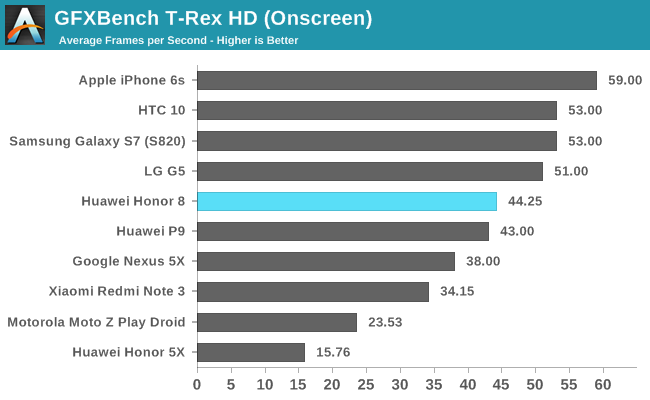
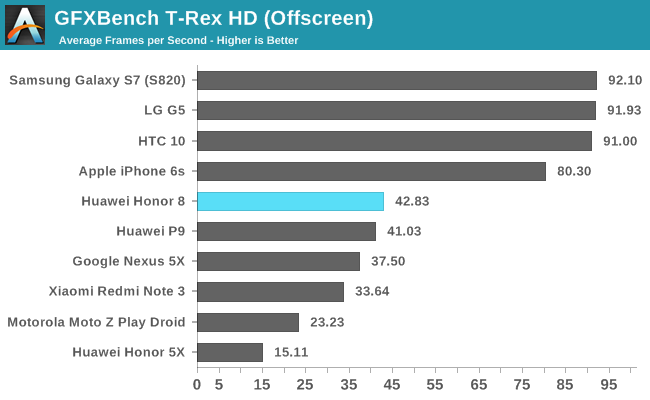
We can already see the effects of this design decision in the older OpenGL ES 2.0-based GFXBench T-Rex game simulation, where the Snapdragon 820 phones outpace the Honor 8 by a factor of two when rendering offscreen at 1080p. Comparing it to other phones at or below its price point shows it holds a 27% advantage over Xiaomi’s Redmi Note 3, which uses a Qualcomm Adreno 510 GPU, and delivers almost twice the performance of the Moto Z Play Droid and its Adreno 506 GPU.
Even when rendering onscreen at a higher 1440p resolution, the three Snapdragon 820 phones still outpace the 1080p Honor 8, although by a much smaller margin.
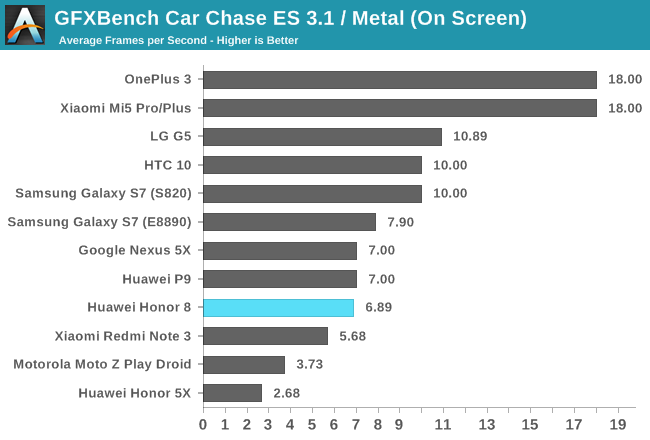
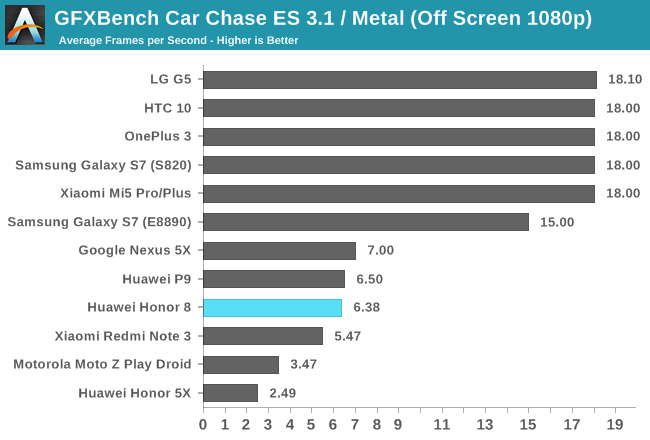
GFXBench Car Chase is a game simulation that uses the latest features, such as hardware tessellation, in OpenGL ES 3.1 plus Android Extension Pack (AEP) and puts a lot of stress on shader performance. The Adreno 530 GPU in the Snapdragon 820 delivers excellent ALU performance, outpacing the Honor 8 by 3x when rendering at the same resolution offscreen. The Exynos 8890’s eight extra cores pay dividends in this workload, allowing it to outperform the Honor 8 by a factor of two, which is similar to the difference in theoretical ALU performance.
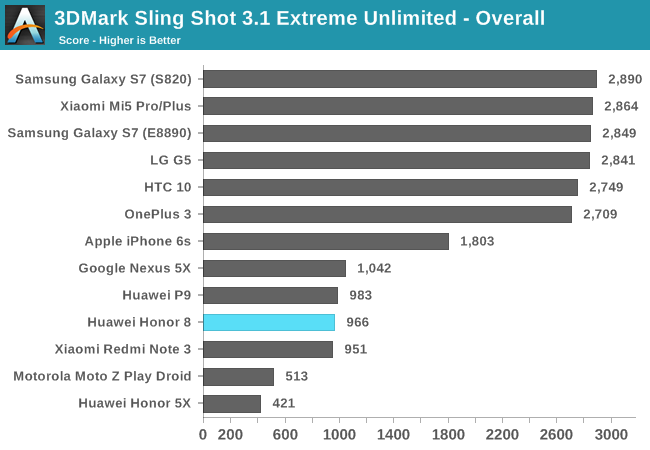


3DMark Sling Shot Extreme uses either OpenGL ES 3.1 on Android or Metal on iOS and stresses the GPU and memory subsystems by rendering offscreen at 1440p (instead of 1080p like our other tests). With more pixels to process, the Honor 8 falls even further behind. The phones with Snapdragon 820 and Exynos 8890 are about 4x faster in the graphics tests. It even falls slightly behind the Xiaomi Redmi Note 3 Pro in the first graphics test that focuses more on processing geometry, but pulls about even in the second test that stresses pixel shading.
The finishing order looks quite different in the Physics test, which focuses on CPU and memory controller performance. The Kirin 950/955 hybrid memory controller appears particularly adept at handling the more random memory access pattern used by this test, something Apple’s SoCs have struggled with for some time.
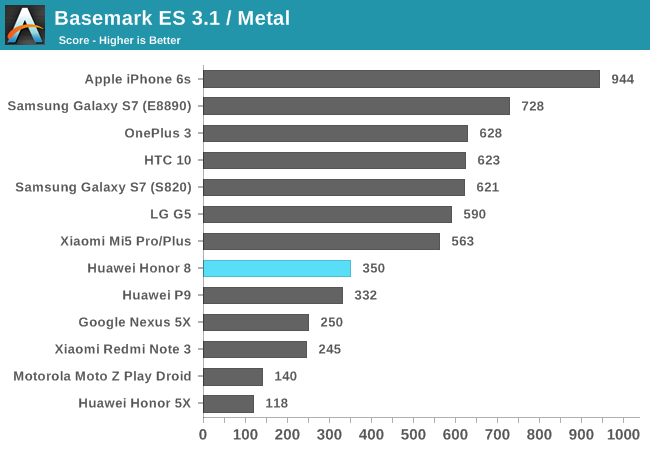
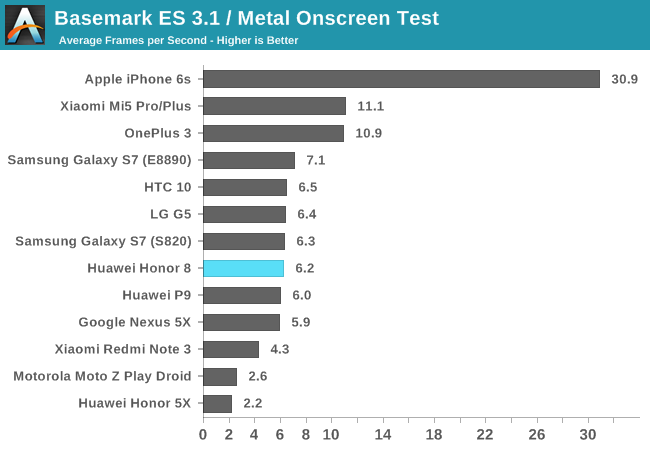
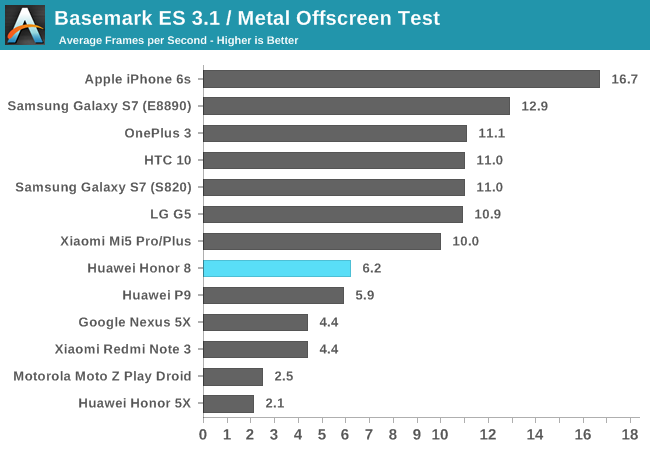
Basemark ES 3.1 also uses either OpenGL ES 3.1 on Android or Metal on iOS. Its rendering pipeline and feature set are similar to GFXBench 4.0 Car Chase, except it does not utilize tessellation. There’s both on onscreen and offscreen test, with the offscreen test rendering at 1080p.
The iPhone 6s performs well, partially because it’s using Apple’s Metal API and partially because it’s only rendering at 750p for the onscreen test. The Xiaomi Mi 5 and OnePlus 3 have 1080p displays, which also gives them an advantage over the 1440p phones in the onscreen test.
Looking at the offscreen results shows that the Galaxy S7 and its Mali-T880 GPU in a 12 core configuration holding a small advantage over the Adreno 530. The Honor 8 and P9 fall significantly behind once again, but they do perform better than the Moto Z Play Droid.
While the Honor 8 cannot match the peak graphics performance of current flagship phones, including the similarly priced OnePlus 3, it does support the current graphics APIs and features. It’s also sufficiently powerful enough to play most games currently available on Android. The Honor 8 is not the ultimate gaming weapon; there will be occasional stutters and it’s possible there are some intense games it cannot play, but it generally provides an adequate gaming experience.










95 Comments
View All Comments
s.yu - Thursday, October 13, 2016 - link
And how many buyers are gonna go on and calibrate it? You need a Spyder for that?tipoo - Thursday, October 13, 2016 - link
Well, the OP3 launched with bad calibration, that was much improved with a software update. So if the screen is good and just the calibration is off, maybe they could do that.mczak - Thursday, October 13, 2016 - link
I am really wondering about the glass surfaces. Unlike the P9 and some other high-end Huawei phones, the Honor line doesn't use gorilla glass. Some reviewers saying it's just ordinary glass - which shouldn't be the case (reportedly it should use some glass from NEG), but I'm really wondering if scratch resistance is at least in the decent category...Pino - Thursday, October 13, 2016 - link
"It’s not perfect (I’ve yet to see a phone that is)"Why don't you give ZTE Axon 7 a shot?
Rocket321 - Thursday, October 13, 2016 - link
I second this, I'd love to see an in depth Axon 7 review.FlyBri - Thursday, October 13, 2016 - link
I totally agree -- the fact they haven't done a review of the Axon 7 at all yet is a bit disturbing. Also, in this review, they mention competitors in the same price range such as the OnePlus 3, but fail to mention the Axon 7, which many could argue is a better phone.tipoo - Friday, October 14, 2016 - link
You're saying that would qualify as perfect? I don't know that much about it, but at a brief glance it looks like it has a perfectly unpredictable camera, for onehttp://mobilesyrup.com/2016/09/06/zte-axon-7-revie...
pedjache - Friday, October 14, 2016 - link
You...cant be serious?tipoo - Friday, October 14, 2016 - link
About what? The OPs comment was if you're looking for a perfect phone, look at the Axon 7, yet in a brief look at reviews I already found sluggish camera performance and UI freezing issues with it...Good despite that? Sure, I guess. But "perfect"? *That* can't be serious.melgross - Thursday, October 13, 2016 - link
I'd just like to make it clear that Leica doesn't make the lenses for the P9, nor did they design them. Leica itself has made that clear. What Leica has said about that was that they approved the lens designs, and did some basic tests of the camera, giving it their approval.What this means is unclear, because the cameras are ok, but nothing special. My feeling is that it isn't much more than marketing. Leica gets paid a small amount, and Huawai gets to stamp Leica on its phones.